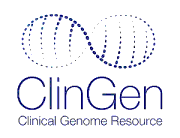Stage II: Summary Report Secondary Findings in Adults Non-diagnostic, excludes newborn screening & prenatal testing/screening Permalink Stage I Survey Update History Stage 2 Status (Adult):Complete (Actionability curation complete.)
Topic
Narrative Description of Evidence
Ref
1. What is the nature of the threat to health for an individual carrying a deleterious allele?
Prevalence of the Genetic Disorder
Clinical Features
(Signs / symptoms)
(Signs / symptoms)
NF2 is characterized by the development of nervous system tumors (schwannomas and meningiomas), ocular abnormalities, and skin tumors. Bilateral vestibular schwannomas occur in 95% of adult patients; vestibular schwannoma growth rates are extremely variable, both between patients and over time in the same patient. Schwannomas typically affect both vestibular nerves, leading to hearing loss and deafness, tinnitus, dizziness and imbalance. While the tumors caused by NF2 are not malignant, their anatomical location and multiplicity lead to great morbidity and early mortality.
Natural History
(Important subgroups & survival / recovery)
(Important subgroups & survival / recovery)
Average age of onset in individuals with NF2 is 18 to 24 years (range birth to 70 years). Nearly all affected individuals develop bilateral vestibular schwannomas by age 30. The average age of death is 36 years; actuarial survival from correct diagnosis is 15 years. NF2 has no racial or ethnic predilections. Childhood-onset NF2 typically presents with non-8th nerve tumors and non-vestibular symptoms, while adult-onset NF2 typically presents with vestibular symptoms. Age at diagnosis, presence of intracranial meningiomas, type of treatment center and type of NF2 mutation are informative predictors of the risk of mortality. Age at diagnosis is, by far, the strongest single predictor.
2. How effective are interventions for preventing harm?
Information on the effectiveness of the recommendations below was not provided unless otherwise stated.
Information on the effectiveness of the recommendations below was not provided unless otherwise stated.
Patient Management
At diagnosis, the following evaluations are recommended: head MRI, hearing evaluation including BAER, ophthalmologic evaluation, cutaneous evaluation, and a genetics consultation.
(Tier 4)
NF2 patients should be managed in specialty centers. NF2 patients who are managed at specialty centers have a significantly lower risk of mortality than those who are treated at non-specialty centers (relative risk 0.34, 95% CI 0.12-0.98).
(Tier 2)
Hearing preservation and augmentation are important in the management of individuals with NF2; all affected individual and their families should be referred to an audiologist.
(Tier 2)
A cervical spine scan should be performed before cranial surgery to prevent complications from manipulation under anesthesia. Lumbosacral imaging should be performed before regional analgesia is given.
(Tier 3)
Surveillance
MRI screening every 2 years for patients less than 20 and every 3 years for older patients should be sufficient for at-risk patients without tumors. The initial MRI scan could be at 10-12 years of age, or earlier in severely affected families. In 10% of cases, individuals with NF2 become symptomatic before 10 years of age. Once tumors are present, MRI screening should be at least annual until the individual growth rate is established. Annual audiological tests, including auditory brainstem response, may be useful. A full annual neurological examination is a wise precaution, with a spinal MRI every 2-3 years unless no tumors are present on the initial scan.
(Tier 2)
Family Management
Children of affected patients should be considered at 50% risk of NF2 and screening for NF2 can start at birth. All NF2 patients and their families should have access to genetic testing; presymptomatic genetic testing is an integral part of the management of NF2, allowing for presymptomatic clinical screening.
(Tier 2)
Circumstances to Avoid
No circumstances-to-avoid recommendations have been provided.
3. What is the chance that this threat will materialize?
Mode of Inheritance
Autosomal Dominant
Prevalence of Genetic Mutations
Prevalence of NF2 mutations was not identified.
Penetrance
OR
Relative Risk
(Include any high risk racial or ethnic subgroups)
OR
Relative Risk
(Include any high risk racial or ethnic subgroups)
Penetrance is close to 100%. Virtually all individuals who have a pathogenic germline mutation develop the disease in an average lifetime.
(Tier 4)
Information on relative risk was not available.
Expressivity
4. What is the Nature of the Intervention?
Nature of Intervention
Management of NF2 requires a variety of non-invasive screening tests.
5. Would the underlying risk or condition escape detection prior to harm in the settting of recommended care?
Chance to Escape Clinical Detection
Regular screening (MRI, neurological, audiology) is recommended beginning at diagnosis, or earlier for family members. These screenings are above and beyond general population recommendations.
Final Consensus Scores
Outcome / Intervention Pair
Severity
Likelihood
Effectiveness
Nature of the
Intervention
Intervention
Total
Score
Score
Vestibular schwannoma / MRI/Screening
2
3B
2B
3
10BB
Description of sources of evidence:
Tier 1: Evidence from a systematic review, or a meta-analysis or clinical practice guideline clearly based on a systematic review.
Tier 2: Evidence from clinical practice guidelines or broad-based expert consensus with non-systematic evidence review.
Tier 3: Evidence from another source with non-systematic review of evidence with primary literature cited.
Tier 4: Evidence from another source with non-systematic review of evidence with no citations to primary data sources.
Tier 5: Evidence from a non-systematically identified source.
Date of Search:
06.20.2014
Reference List
1.
Neurofibromatosis 2.
Gene reviews.
(2011)
Website: http://www.ncbi.nlm.nih.gov/books/NBK1201/
2.
Neurofibromatosis type 2.
Orphanet.
(2009)
Website: http://www.orpha.net/consor/cgi-bin/OC_Exp.php?Expert=637
